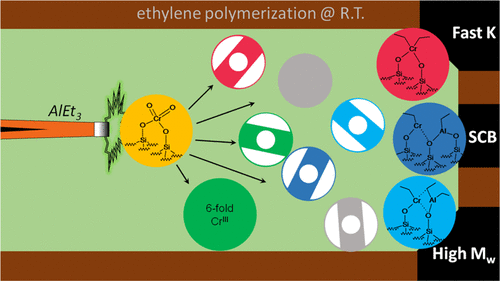当前位置:
X-MOL 学术
›
ACS Catal.
›
论文详情
Our official English website, www.x-mol.net, welcomes your
feedback! (Note: you will need to create a separate account there.)
Rationalizing the Effect of Triethylaluminum on the Cr/SiO2 Phillips Catalysts
ACS Catalysis ( IF 11.3 ) Pub Date : 2020-02-10 , DOI: 10.1021/acscatal.9b04726 Giorgia A. Martino 1 , Alessandro Piovano 1 , Caterina Barzan 1 , Jabor Rabeah 2 , Giovanni Agostini 2 , Angelika Bruekner 2 , Giuseppe Leone 3 , Giorgia Zanchin 3 , Takashi Monoi 4 , Elena Groppo 1
ACS Catalysis ( IF 11.3 ) Pub Date : 2020-02-10 , DOI: 10.1021/acscatal.9b04726 Giorgia A. Martino 1 , Alessandro Piovano 1 , Caterina Barzan 1 , Jabor Rabeah 2 , Giovanni Agostini 2 , Angelika Bruekner 2 , Giuseppe Leone 3 , Giorgia Zanchin 3 , Takashi Monoi 4 , Elena Groppo 1
Affiliation

|
In contrast to most of the other olefin polymerization catalysts, the Cr/SiO2 Phillips catalyst does not need any activator to develop its activity. However, it is known that the addition of a small amount of metal-alkyls has drastic effects on the catalyst performance, and it is one of the strategies adopted in industrial practice to tailor the properties of the polyethylene produced. In this work, we conducted a systematic investigation on the effect of triethylaluminum on the Cr(VI)/SiO2 catalyst, with the ultimate goal to determine the properties of the Cr sites at a molecular level and to correlate them to the properties of the obtained polyethylene. To this aim, we coupled kinetic tests, spectroscopic methods (diffuse reflectance UV–vis–near-infrared, electron paramagnetic resonance, Fourier-transform infrared spectroscopy of probe molecules), and different polymer characterization techniques. We found that, at an Al/Cr ratio of 2:1, only ca. 50% of the original Cr(VI) sites are reduced to a variety of species comprising: (1) Cr(IV) bisalkyl sites, which are probed by carbon monoxide and are the major actors in the polymerization of ethylene, explaining the faster polymerization initiation rate; (2) 6-fold coordinated Cr(III) sites, which are not accessible by probes and whose amount does not correlate with the catalyst activity; and (3) two types of monografted Cr(II) sites, all deriving from the over-reduction of the Cr(IV) bisalkyl sites, having, respectively, weak and strong Lewis acid characters, the former responsible for in situ α-olefin generation (and hence contributing to the enchainment of short polymer branching) and the latter accounting for the formation of the high-molecular-weight polymer fraction. Overall, our results demonstrate that the catalytic performance of the Cr sites depends not only on the oxidation state but rather on a combination of molecular structure, acidic character, and nature of the ancillary ligands. Hence, by tuning the structure and acidity of the Cr sites, it is possible to move from a system that essentially affords oligomers from ethylene to one that affords high-molecular-weight polymers.
中文翻译:

合理化三乙基铝对Cr / SiO 2 Phillips催化剂的影响
与大多数其他烯烃聚合催化剂相反,Cr / SiO 2 Phillips催化剂不需要任何活化剂即可发挥其活性。然而,已知添加少量的金属烷基对催化剂性能具有巨大影响,并且工业实践中采用的策略之一是定制所生产的聚乙烯的性能。在这项工作中,我们对三乙基铝对Cr(VI)/ SiO 2的影响进行了系统的研究。催化剂的最终目的是在分子水平上确定Cr位的性质,并使它们与所得聚乙烯的性质相关。为此,我们结合了动力学测试,光谱方法(紫外可见-近红外漫反射,电子顺磁共振,探针分子的傅里叶变换红外光谱)和不同的聚合物表征技术。我们发现,在Al / Cr比为2:1的情况下,只有 50%的原始Cr(VI)位点被还原为多种物种,包括:(1)Cr(IV)双烷基位点,由一氧化碳探测并且是乙烯聚合的主要参与者,这说明了聚合速度更快启动率 (2)6价的Cr(III)配位,探针无法触及且其量与催化剂活性无关的; (3)两种类型的单价接枝的Cr(II)位点,均来自过度还原的Cr(IV)双烷基位点,分别具有弱和强路易斯酸特征,前者负责原位α-烯烃生成(并因此有助于短聚合物支链的束缚),而后者解释了高分子量聚合物馏分的形成。总体而言,我们的结果表明,Cr位点的催化性能不仅取决于氧化态,还取决于分子结构,酸性和辅助配体性质的组合。因此,通过调整Cr位的结构和酸度,
更新日期:2020-02-11
中文翻译:

合理化三乙基铝对Cr / SiO 2 Phillips催化剂的影响
与大多数其他烯烃聚合催化剂相反,Cr / SiO 2 Phillips催化剂不需要任何活化剂即可发挥其活性。然而,已知添加少量的金属烷基对催化剂性能具有巨大影响,并且工业实践中采用的策略之一是定制所生产的聚乙烯的性能。在这项工作中,我们对三乙基铝对Cr(VI)/ SiO 2的影响进行了系统的研究。催化剂的最终目的是在分子水平上确定Cr位的性质,并使它们与所得聚乙烯的性质相关。为此,我们结合了动力学测试,光谱方法(紫外可见-近红外漫反射,电子顺磁共振,探针分子的傅里叶变换红外光谱)和不同的聚合物表征技术。我们发现,在Al / Cr比为2:1的情况下,只有 50%的原始Cr(VI)位点被还原为多种物种,包括:(1)Cr(IV)双烷基位点,由一氧化碳探测并且是乙烯聚合的主要参与者,这说明了聚合速度更快启动率 (2)6价的Cr(III)配位,探针无法触及且其量与催化剂活性无关的; (3)两种类型的单价接枝的Cr(II)位点,均来自过度还原的Cr(IV)双烷基位点,分别具有弱和强路易斯酸特征,前者负责原位α-烯烃生成(并因此有助于短聚合物支链的束缚),而后者解释了高分子量聚合物馏分的形成。总体而言,我们的结果表明,Cr位点的催化性能不仅取决于氧化态,还取决于分子结构,酸性和辅助配体性质的组合。因此,通过调整Cr位的结构和酸度,





















































 京公网安备 11010802027423号
京公网安备 11010802027423号